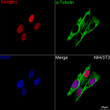| Function | Required for formation of the RNA induced silencing complex (RISC). Component of the RISC loading complex (RLC), also known as the micro-RNA (miRNA) loading complex (miRLC), which is composed of DICER1, AGO2 and TARBP2. Within the RLC/miRLC, DICER1 and TARBP2 are required to process precursor miRNAs (pre-miRNAs) to mature miRNAs and then load them onto AGO2. AGO2 bound to the mature miRNA constitutes the minimal RISC and may subsequently dissociate from DICER1 and TARBP2. May also play a role in the production of short interfering RNAs (siRNAs) from double-stranded RNA (dsRNA) by DICER1. Binds in vitro to the PRM1 3'-UTR. Seems to act as a repressor of translation. For some pre-miRNA substrates, may also alter the choice of cleavage site by DICER1. Negatively regulates IRF7-mediated IFN-beta signaling triggered by viral infection by inhibiting the phosphorylation of IRF7 and promoting its 'Lys'-48-linked ubiquitination and degradation. (Microbial infection) Binds to the HIV-1 TAR RNA which is located in the long terminal repeat (LTR) of HIV-1, and stimulates translation of TAR-containing RNAs. This is achieved in part at least by binding to and inhibiting EIF2AK2/PKR, thereby reducing phosphorylation and inhibition of EIF2S1/eIF-2-alpha. May also promote translation of TAR-containing RNAs independently of EIF2AK2/PKR. Mediates recruitment of FTSJ3 methyltransferase to HIV-1 RNA, leading to 2'-O-methylation of the viral genome, allowing HIV-1 to escape the innate immune system. |
| Protein Name | Risc-Loading Complex Subunit Tarbp2Tar Rna-Binding Protein 2Trans-Activation-Responsive Rna-Binding Protein |
| Database Links | Reactome: R-HSA-203927Reactome: R-HSA-426486Reactome: R-HSA-9833482 |
| Cellular Localisation | CytoplasmPerinuclear RegionNucleus |
| Alternative Antibody Names | Anti-Risc-Loading Complex Subunit Tarbp2 antibodyAnti-Tar Rna-Binding Protein 2 antibodyAnti-Trans-Activation-Responsive Rna-Binding Protein antibodyAnti-TARBP2 antibodyAnti-TRBP antibody |
Information sourced from Uniprot.org

























